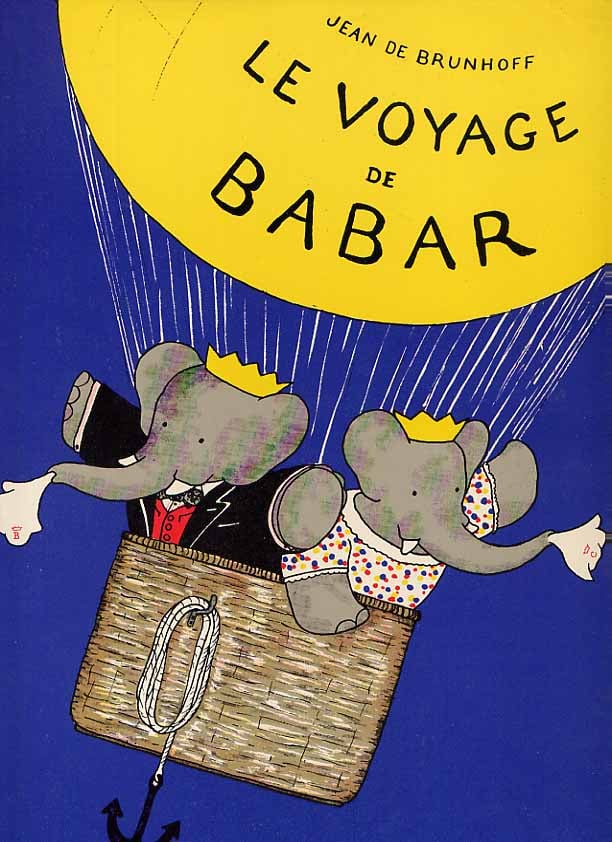
- Babar's Travels
- Published by: French and European Publications
- Level: Beginner
- First Published in:
The Babar series is well-known throughout the world as a French classic in children’s illustrated literature. In this particular tale, Babar the king of the elephants goes on a honeymoon with his wife, Céleste.

The Babar series is well-known throughout the world as a French classic in children’s illustrated literature. In this particular tale, Le Voyage de Babar, the second installment in the series, Babar the king of the elephants goes on a honeymoon with his wife, Céleste. The book was written in 1932, and the effects of World War I and neocolonialism can be felt throughout.
As Babar and Céleste leave elephant land, their hot air balloon “glisse dans le ciel” (glides in the sky), and their surroundings are “doux” (soft) and “leger” (light). The word choice in this first part uses jargon specifically relevant to hot air balloons, and the tranquility described contrasts with the “violent tempéte” (violent storm) with which the hot air balloon is “surprise brusquement” (abruptly surprised). The protagonists have to brave the weather in the basket of the balloon.
"The book was written in 1932, and the effects of World War I and neocolonialism can be felt throughout."
When they crash-land – luckily, on an island – the balloon itself “s’aplatit, dégonflé” (flattens, deflates). They dry out their clothes and cook themselves a “soupe au riz,” a recipe that could be considered a North African specialty. As Céleste is napping alone, “feroces sauvages cannibals” (fierce savage cannibals) attack her. What follows is quite a racist depiction of African natives, as Babar saves his wife in the nick of time, vanquishing the cannibals. Later, they encounter a whale, who very politely says, “Je suis enchantée de faire cotre connaissance” (I’m delighted to make your acquaintance). This is a very correct way of saying, “Nice to meet you.” If meeting someone today, one could easily get by with “enchantée” alone. The whale then gives the couple a lift, but promptly forgets them, as he is “étourdie” (quite forgetful).
A boat picks up Babar and Céleste, and they are placed in “l’écurie” (the stables), where they are outraged at being given “foin” (hay) like donkeys. This scene is quite poignant, as we side with the protagonists and question our personal treatment of animals. The captain then hands Babar and Céleste over to “un dompteur” (a ringmaster), and the elephants become students at a circus against their will. Luckily, they break out and hide at an old lady’s place, who very kindly serves them croissants and coffee the next morning, a typical French breakfast at the time. Meanwhile, the clowns look everywhere for the missing elephants, saying: “Petits, eh! Petits! Où vous cachez vous?” This is very silly and emphasizes that the speakers are clowns.
While this is happening, back in the elephant kingdom, Babar’s cousin, Arthur, is up to no good. He sets off a “petard” (a stick of dynamite) on a rhino’s tail, and this rhino, named Rataxès, calls his aggressor a “galopin” after being attacked, branding him as a badly-raised boy. Arthur’s prank ends up motivating the rhinos to declare war on the elephants. When Babar, Céleste, and the old lady return to the elephant kingdom, they find the trees all destroyed. A lot of sadness is conveyed through word choice: “muets de surprise,” “tristes,” and “chagrin” all mirror the main characters’ shock at finding their home ruined. As it happens, the trees have been casualties in the first battle of the war. Rataxès promises to “tirer les oreilles de ce jeune roi Babar” (pinch the ears of young king Babar), hoping to treat him like a naughty child as well. Happily, thanks to a “stratagème” by “grand general” Babar, the elephants are saved. Though Le Voyage de Babar could be considered racist on some levels, it does challenge readers to consider 1930s presumptions and current views on animal treatment.
